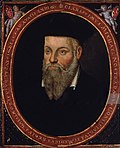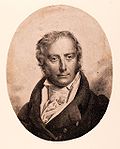Salon-de-Provence
| Salon-de-Provence | ||
|---|---|---|

|
|
|
| region | Provence-Alpes-Cote d'Azur | |
| Department | Bouches-du-Rhône | |
| Arrondissement | Aix-en-Provence | |
| Canton |
Salon-de-Provence-1 Salon-de-Provence-2 |
|
| Community association | Métropole d'Aix-Marseille-Provence | |
| Coordinates | 43 ° 38 ' N , 5 ° 6' E | |
| height | 53-325 m | |
| surface | 70.30 km 2 | |
| Residents | 45,528 (January 1, 2017) | |
| Population density | 648 inhabitants / km 2 | |
| Post Code | 13300 | |
| INSEE code | 13103 | |
| Website | salon-de-provence.org | |
 Moss fountain at night |
||
Salon-de-Provence (formerly Salon-de-Crau ) is a municipality with 45,528 inhabitants (as of January 1, 2017) in southern France , in the Bouches-du-Rhône department , in the former province of Provence . It is located between Aix-en-Provence , Arles , Cavaillon and Marseille on the A 7 motorway (Lyon-Marseille). The BA 701 air force base ( base aérienne 701 ) , where the Patrouille de France is based, is also located in the municipality of Salon-de-Provence.
history
In ancient times , Salluvians settled in the area and mainly farmed sheep and traded salt . Around 125 BC Chr. Put Romans the swamps around the Touloubre dry and founded on the rock of Puech a Castrum which a section of the Via Aurelia was to secure. A first settlement developed around the fortress, today's Empéri Castle .
In the Middle Ages , the "villa Sallonne" belonged to the Holy Roman Empire . The emperors transferred the rule of Salon to the archbishops of Arles . The village lost some of its freedoms and only received official city rights in 1404 . Under the rule of the Provence counts , including the well-known René the Good , Salon experienced an economic boom in the fifteenth century. With the annexation of the county of Provence to the Kingdom of France after the death of King René in 1481, the archbishops lost part of their authority.
In the sixteenth century, like the rest of France, Salon was swept away by the Huguenot Wars . One of the most famous residents of the city was Nostradamus , who wrote his Centuries here in 1547 . Another important contemporary was Adam de Craponne , who created the Canal de Craponne in 1559 to irrigate the dry surrounding area. In 1564, King Charles IX visited and his mother Caterina de 'Medici took over the city and provided it with today's leopard coat of arms.
In the eighteenth century, silk manufacturers began to settle in Salon . The economic boom began in the nineteenth century with the development of soap factories and the trading of oil, soap and coffee. The city's new wealth led to the construction of townhouses and castles. Two of the soap factories are still active today, and the soap trade continues to occupy an important position. Salon-de-Provence has been the seat of the French Air Force School since 1938 and has also been known for the stationing of the Patrouille de France since 1964 .
Population development
| year | 1962 | 1968 | 1975 | 1982 | 1990 | 1999 | 2006 | 2008 | 2017 |
|---|---|---|---|---|---|---|---|---|---|
| Residents | 21,393 | 30,722 | 34,576 | 34,846 | 34,064 | 37,079 | 40.147 | 41,411 | 45,528 |
Attractions
Salon-de-Provence is the place where Nostradamus , a doctor and author of prophecies of the 16th century, lived and died. His house in the old town was set up as a museum dedicated to him.
Empéri Castle
The Empéri Castle, located in the center of the old town on the Puech rock, dominates the Crau plain, where there was already a Roman castrum. The castle was a residence of the Archbishops of Arles and the Roman-German Emperor (from which the name Empéri is derived) and was built between the 9th and 13th centuries.
Saint-Michel
The Saint-Michel church was built in the 13th century and is a typical example of Provencal architecture with its arcaded bell tower and sculptures in Romanesque style. In the tympanum of the portal, the Archangel Michael is depicted with two snakes, including an Easter lamb surmounted by a Maltese cross. The remaining images show floral ornaments. A steeple was added in the 15th century, which was used as a clock tower until the 17th century.
town hall
Construction of the town hall began in 1655. It is a classical style building, with a balustrade roof and alternating triangular and curvilinear gables. Two allegories, depicting temperance and caution, recall the virtues necessary for good government in a city. Two corner turrets on both sides of the building ensure a balanced appearance.
clock tower
The clock tower was built in the 17th century in place of the north tower of the city wall. The place was chosen according to the wind direction of the mistral, which allowed the sound of the bell to spread better. Construction stopped by the plague was completed in 1664 with the addition of the wrought iron bell tower with three bells. After the most recent renovation, you can now see a weekly calendar on the side facing the old town, and on the side facing the new town, a clock shows the lunar cycles.
Moss fountain
This fountain, a real landmark of the city, already existed in the 16th century. Lime deposits allowed the fountain bowls, the moss and the vegetation to grow together and give the fountain its characteristic shape today.
- Picture gallery
Town twinning
- Wertheim , Baden-Württemberg , since 1964
- Huntingdon and Godmanchester , England , since 1974
- Gubbio , Italy , since 1978
- Aranda de Duero , Spain , since 1992
- Szentendre , Hungary , since 1997
Personalities
- Louis Aleman (1390–1450), French cardinal
- Michel de Nostredame , called Nostradamus (1503–1566), French doctor and seer
- Adam de Craponne (1526–1576), French hydraulic engineer
- Jean Baptiste Christophe Fusée Aublet (1720–1778), French botanist
- Robert de Lamanon (1752–1787), member of the Lapérouse expedition
- Jean-Baptiste-Sauveur Gavaudan (1772-1840), French actor, singer and theater director
- Yves Farge (1899–1953), journalist and politician
- Milly Mathis (1901-1965), French actress
- Roger Carcassonne (1903-1992), politician
- Raymond Reynaud (1920–2007), French brut painter
- Pierre Cayol (* 1939), French painter
- Pierre Bonelli (1939-2004), French manager
- Franck Esposito (1971), French swimmer
- Mathilde Gros (* 1999), cyclist
Web links
- Official website of the city (French)
- City charter around 1293 (Latin - French)
- City picture gallery











